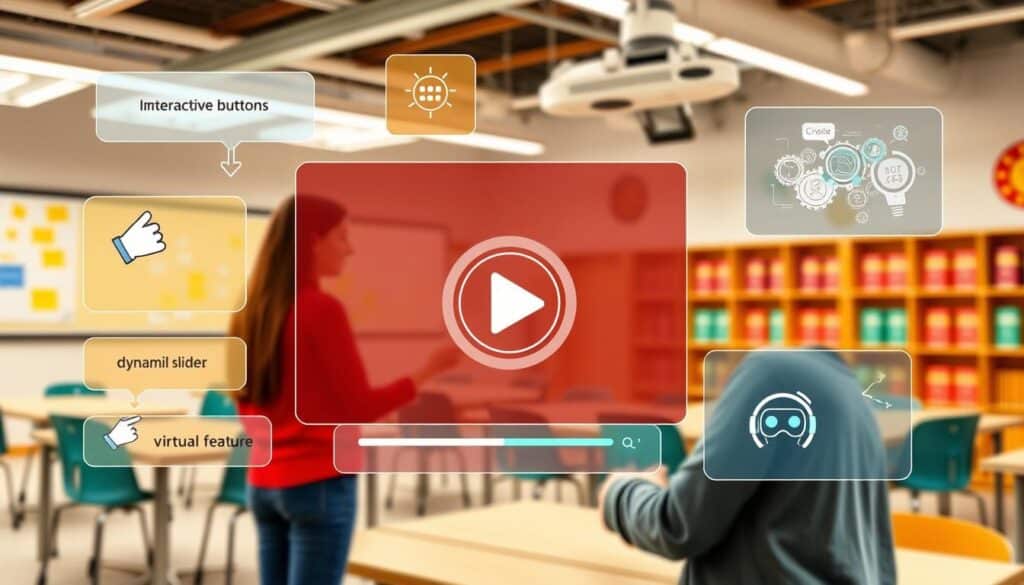In today’s fast-changing world, knowing and skills are key for growth. Learning modules are great tools for focused learning. They are used in corporate training, schools, and online platforms. This guide will show you how to create modules, from start to finish.
Key Takeaways
- Learning modules offer a structured and personalized approach to skill development and knowledge acquisition.
- Effective module design aligns learning outcomes, teaching activities, and assessments, ensuring a constructive learning experience.
- Interactive elements and video-based content can significantly enhance engagement and retention rates among learners.
- Considering the broader context, such as the department, institution, and industry, can inform the module’s design and relevance.
- Sensei LMS provides a comprehensive platform for creating, delivering, and managing effective learning modules.
What are Learning Modules?
Learning modules are self-contained units of instruction. They are designed to teach specific knowledge or skills. These modules have a set format, with clear learning goals, content, activities, and assessments.
They offer focused learning experiences for individuals or groups. This makes them a valuable tool in the world of learning and development.
Definition and Types of Learning Modules
There are many types of learning modules, each meeting different learning needs. Here are a few:
- E-learning Modules – Interactive, self-paced digital learning experiences delivered through online platforms or applications.
- Instructor-led Training (ILT) Modules – Learning modules facilitated by an instructor, either in-person or virtually, allowing for real-time interaction and guidance.
- Microlearning Modules – Bite-sized learning units focused on specific skills or concepts, designed for quick consumption and retention.
These modules are made to offer engaging and targeted learning opportunities. They help individuals develop and refine their knowledge and abilities.
“Learning modules are the building blocks of effective training programs, enabling learners to develop targeted skills and knowledge in a structured and engaging manner.”
The Importance of Effective Learning Modules

Effective learning modules are key to good training programs. Studies show that most skills are learned on the job or from colleagues. Yet, 93% of workers want training programs that are clear and well-planned.
To make effective learning modules, you need to plan well. You must know your audience, set clear training objectives, and add interactive elements. This makes learning fun and effective.
- Learners keep 25%-60% more info with interactive e-learning than old methods.
- Using adaptive learning can boost engagement by up to 50%.
- Adding reward systems in e-learning can raise student performance by 90%.
To make learning stick, use assessments as checks, not just finals. Regular self-checks help solidify knowledge and spot what needs more work.
Also, module-based objectives help students know what to aim for. Keep objectives to 3-4 per module. Some modules might need fewer goals.
By focusing on effective learning modules, companies can improve training outcomes. This ensures employees have the skills to do well.
Planning and Preparation for Creating Learning Modules
Making effective learning modules needs careful planning and prep. First, you must know who your audience is and what you want to teach them. Knowing about your audience’s age, education, and how they learn helps you design the right content and format.
Identifying the Target Audience
Understanding your audience is key. Look at their age, education, and what they already know. Also, think about how they like to learn and their tech skills. This info helps you make your modules engaging and effective.
- Age and educational level
- Prior knowledge and experience with the subject matter
- Learning preferences (e.g., visual, auditory, kinesthetic)
- Technological proficiency and access to digital tools
This knowledge lets you tailor your modules to meet your audience’s needs. This makes the training more engaging and effective.
Establishing Clear Training Objectives
Good training goals should be SMART. They guide both trainers and learners. Goals should clearly state what learners will gain or improve by taking the training.
It’s also key to think about how each module fits into the bigger picture. This ensures each module supports the overall learning journey and the organization’s goals.
By knowing your audience and setting clear goals, you can make learning modules that are engaging and relevant. This leads to better training results.
Selecting the Right Format and Tools for Learning Modules

Creating an effective learning module starts with choosing the right format. You should think about what you want to achieve and who you’re teaching. You can pick from text, video, interactive, or multimedia formats. Each one has its own benefits and can make learning more engaging.
Text-based modules are great for sharing detailed information. Videos are perfect for showing how things work or explaining visually. Interactive elements like quizzes can make learning fun and help you remember more. Modules that use text, images, and interactivity offer a complete learning experience.
The Sensei LMS for WordPress is a great tool for creating and managing your modules. It’s easy to use and lets you build different types of content. You can use it to make your WordPress site a learning hub.
“91% of people have watched an explainer video to learn more about a product or service.”
Sensei LMS also works well with other WordPress plugins. This means you can create a learning space that fits your needs. Whether you’re teaching online, selling courses, or training your team, Sensei LMS has what you need.
Choosing the right format and using a platform like Sensei LMS makes your modules engaging and accessible. It helps you reach your training goals and grow your learning space.
The Process of Creating Effective Learning Modules

When making training modules, it’s key to show how the content matters to learners. Use clear descriptions, set learning goals, and talk about what learners will gain. This makes the module easy to follow and remember. Sensei LMS helps by offering templates for lessons, keeping everything consistent.
Adding fun stuff like quizzes and videos makes learning better. These elements help learners understand and remember more. Plus, they make the learning fun and stick in their minds.
Highlighting the Value and Relevance
Writing good course descriptions is important. They should explain the module’s purpose and what learners will get out of it. Setting clear learning goals helps learners know what they’ll learn.
Structuring and Organizing Content
Breaking the module into clear lessons helps learners get and keep the information. Sensei LMS makes it easy to keep the lessons consistent and engaging.
Incorporating Interactive Elements
Adding interactive parts like quizzes and videos boosts learning. These elements make learning fun and help learners remember better.
Also Read : Discover The Benefits Of Study Online
“The key to effective learning modules is to create content that is both informative and engaging. By highlighting the value, structuring the content, and incorporating interactive elements, you can maximize the impact of your training program.”
Conclusion
Learning modules are key for growth in today’s fast-changing world. They help us grow personally and professionally. By planning well and focusing on the audience, you can make your training great.
Sensei LMS is a powerful tool for creating engaging learning modules. It works well for many types of learners. This makes learning fun and flexible.
Being good at making learning modules can really help your students. Spending time on making them interactive and relevant is important. It helps learners remember more and feel happy with their training.
When making learning programs, think about what your learners need. Make sure your goals match theirs. Use the latest technology to make learning exciting.
This way, you help your learners succeed in a changing world. You also help them grow personally and professionally.
FAQs
Q: What are online learning modules?
A: Online learning modules are self-paced learning resources designed to facilitate student learning through various interactive learning activities. They often include course content that can be accessed anytime, allowing learners to engage at their own pace.
Q: How can I promote interactive learning in my training modules?
A: To promote interactive learning and collaboration within your training modules, consider incorporating tools that promote interactive learning, such as quizzes, discussion forums, and group projects. These elements encourage engagement and enhance the learning experience.
Q: What do I do if I need more help with the learning modules?
A: If you need more help, you can explore additional resources provided within the learning management system. Many platforms offer support options like FAQs, forums, and direct access to instructors to assist you with any challenges you may face.
Q: Can I complete the learning modules in any order?
A: Yes, most online learning modules allow you to complete the content in any order. This flexibility enables you to focus on topics of interest or those that align with your learning objectives.
Q: What is a certificate of completion, and how can I earn one?
A: A certificate of completion is awarded to learners who successfully finish a course or training module. To earn one, you typically need to complete all required learning activities and assessments within the course content.
Q: How does progress tracking work in online learning modules?
A: Progress tracking in online learning modules allows you to monitor your advancement through the course content. Most learning management systems provide dashboards that display completed modules, grades, and any outstanding tasks.
Q: What types of learning activities are included in interactive learning modules?
A: Interactive learning modules often include a variety of learning activities such as quizzes, simulations, video discussions, and collaborative group projects. These activities are designed to enhance engagement and retention of information.
Q: Are self-paced learning modules suitable for all learners?
A: Yes, self-paced learning modules can be suitable for all learners, especially those who prefer to learn at their own speed. They cater to different learning styles and allow individuals to revisit content as needed.
Q: What resources are available if I want to improve my learning experience?
A: If you’re interested in learning more effectively, many learning management systems offer additional resources, including supplementary materials, study guides, and access to expert instructors who can provide guidance.
Source Links
- https://senseilms.com/how-to-create-a-training-module/
- https://www.uaces.org/resources/articles/how-design-effective-teaching-modules
- https://blackboard.niu.edu/blackboard/_pdf/guides/learning_modules.pdf
- https://community.canvaslms.com/t5/Canvas-Basics-Guide/What-are-Modules/ta-p/6
- https://newroom-connect.com/blog/what-makes-e-learning-interactive-modules-effective/?lang=en
